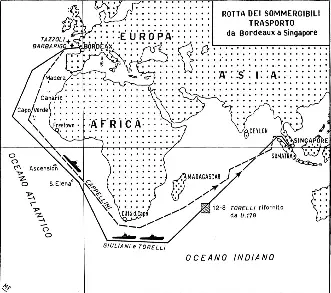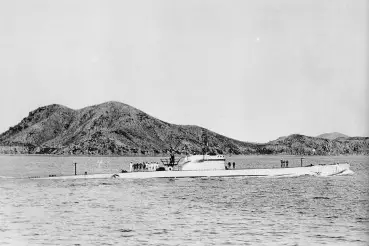Context
The lack of specific raw materials and resources necessary for the war effort severely affected the European Axis powers and their industrial apparatus. Some strategic resources like rubber could only come from the Japanese occupied territories in South-East Asia and were transported by ships lucky or skilled enough to pass through the allied naval blockade (the so-called “blockade runners’”).
In Late 1942, Axis blockade runners’ missions reached a negative peak and thus the German high command started to look for alternatives. The only plausible solution was to transport such resources via submarine, thus increasing the safety of the voyage (but also the duration). This solution seemed even more feasible after the successful voyage to Europe of the Japanese submarine I-30, which reached Bordeaux in August 1942, in the context of a resource-technology exchange mission.
Underwater transport
The problem was, which units should be used? German U-boots were desperately needed in the Battle of the Atlantic. In addition, their small interiors could hardly serve well for the envisaged transport of strategic materials in a very long voyage. The German Kriegsmarine (KG) then turned their eyes to the few Italian submarines still available in the BETASOM base of Bordeaux. The Italian units had been deployed in the Atlantic since late 1940, however, they had encountered several problems in the Atlantic environment. This was due to their design features and inferior technology. Italian submarines were also generally bigger than the German ones. This was a drawback when it meant fighting against the allied escort ships but now this drawback seemed to provide a new opportunity.

Cappellini and Bagnolini in Bordeaux
To study the modifications needed, in early February 1943, the Germans requested the designs of the Italian submarines based in Bordeaux to the Regia Marina (RM). The Italians passed their designs, exception made for those of the Ammiragli class submarines, the most modern units of the Italian underwater fleet.
In March 1943, the RM and KM agree on the transformation of 9 Italian submarines, in exchange for the same number of type VII-C U-Boot.
In March, transformation works started on the submarines available in Bordeaux (7), while those at sea (2) carrying out offensive actions would wait their turn. These modifications included the removal of all torpedo and torpedo tubes, as well as other devices and equipment needed for offensive actions. The RM decided to establish a small base in Singapore, to provide support to the transport submarines and command of operations would have fallen under Captain Marino Iannucci of the support ship Eritrea, operating since 1941 in the Far East together with the Japanese Navy.
The voyages
The first three submarines were ready by the 8th of May and departed for their mission in the next weeks.
The Cappellini departed on the 11th of May, carrying 95 tons of machine tools and industrial products. The submarine enjoyed a quiet voyage and arrived unharmed in Sabang (in Japanese-occupied Indonesia) on the 9th of July, after a voyage of 59 days. It then proceeded to Singapore escorted by the Eritrea.
Tazzoli departed on the 16th of May, carrying 165 tons of materials and mixed personnel. Radio contact was lost with the submarine after some days and the Tazzoli was never seen again. It was likely sunk by a British bomber used for Anti-Submarine Warfare (ASW).
The Giuliani departed on the 23rd of May, carrying 180 tons of materials and Italian personnel (destined to a base to be established in Singapore). It safely arrived in Sabang on the 28th July, and later in Singapore
The Torelli departed on the 14th of June, carrying 130 tons of materials and mixed personnel. The submarine suffered an attack in the Southern Atlantic but survived. It was refuelled by U-178 in the Indian Ocean and arrived in Sabang on the 27th of August.
The Barbarigo departed on the 16th of June. carrying 130 tons of materials and personnel for the planned base in Singapore. Radio contact was lost a week after their departure, the submarine had suffered the same fate as the Tazzoli a month before.

Painting depicting the attack against the Tazzoli

The routes followed by the Italian submarines
Under a new flag
When Italy signed the armistice with the allies (September 1943) the Germans sized the two Italian submarines left in Bordeaux (Finzi and Bagnolini). The Finzi was in dire conditions and was abandoned in the harbour. The Bagnolini was renamed UIT-22 and, in January 1944, departed from Bordeaux with a German crew, destination Singapore. It was sunk near South African shores by allied aircraft.
The three submarines still in Singapore were captured by the Japanese and subsequently handed over to the Kriegsmarine. In February 1944, the Giuliani (now renamed UIT 23 and manned by a German crew), left Singapore transporting a precious cargo of rubber. It was sunk in the Strait of Malacca by the British submarine HMS Tally Ho.
The Cappellini (UIT 24) and Torelli (UIT 25) remained in the area under German control until May 1945. Their crew were a mix of German and Italian sailors (those who sided with Mussolini and the newly born Italian Social Republic)
When Germany surrendered in May 1945, the Japanese took control of the two units which operated under the Japanese flag (renamed I-503 and I-504) until their destruction in Kobe in August 1945. The Italian sailors imprisoned by the Japanese were repatriated after the war, carried by the ship Eritrea.

Submarine I-503 (ex-Cappellini) under Japanese control
Sources
Bagnasco, E., & Brescia, M. (2013). I sommergibili Italiani1940-1943, Parte I – Mediterraneo.
Bagnasco, E., & Brescia, M. (2014). I sommergibili italiani 1940-1943, Parte II – Oceani.
Giorgerini, G. (1994). Uomini sul fondo.
Mattesini, F. (s.d.). I sommergibili da trasporto di “Betasom” e la cessione di sommergibili tedeschi tipo vii c 42 alla marina italiana.